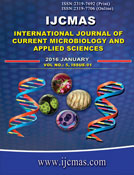


 National Academy of Agricultural Sciences (NAAS)
National Academy of Agricultural Sciences (NAAS)

|
PRINT ISSN : 2319-7692
Online ISSN : 2319-7706 Issues : 12 per year Publisher : Excellent Publishers Email : editorijcmas@gmail.com / submit@ijcmas.com Editor-in-chief: Dr.M.Prakash Index Copernicus ICV 2018: 95.39 NAAS RATING 2020: 5.38 |
A comparative study of indoor contamination in three private and three official schools in Aley, Lebanon was conducted during the spring season of the year 2014. Sampling was performed in each school, from the air, desk-surfaces of classes and water taps of bathrooms. The samples were examined for microbial contamination and the bacterial colony-forming units (CFU) for each site were enumerated. Official schools showed to be highly contaminated (air mean 87 CFU and surface mean 98 CFU) with respect to the private schools (air mean 61 CFU and surface mean 60 CFU). Among the three educational levels, the elementary level was the most contaminated. Fungal contamination was also detected on classes desks and three genera were morphologically identified; Aspergillus, Penicillium and Cladosporium. Eighty morphologically different bacterial isolates were obtained, among which Gram-negative bacteria (52.5 %) were encountered slightly more than Gram-positive bacteria (47.5 %). These isolates were tested for their susceptibility to six commonly used biocides in indoor decontamination; Ajax®, Clorox®, Ethanol 70 %, Dettol®, Easy® and CAMEO®, by well diffusion test. The highest frequency of resistance amongst the eighty bacterial isolates was detected against Easy® (93.75 %), while the lowest frequency was detected against Clorox® (46.25 %). Moreover, the susceptibility of the biocides was in the order: Clorox® > Dettol® > Ajax® > CAMOE® > Ethanol > Easy®. Seven bacterial isolates, which showed reduced susceptibility to three or more biocides were selected and identified. The minimum inhibitory concentration and the minimum bactericidal concentration of the six tested biocides were evaluated against selected isolates, they ranged from 200 l/ml to 900 l/ml. All MIC indexes calculated were less than 4 which displayed the bactericidal activity of the six biocides against the seven tested bacterial strains. Isolate 51 (E. coli) was the least susceptible strain to biocides among the seven selected isolates, the results of the time kill assay revealed that the time needed to kill this isolate by Dettol® was 8 min., while other biocides took longer time to kill it. In addition, the loss of resistance of E. coli against the six biocides was recorded after plasmid curing, which proved the plasmid-mediated resistance.
 |
 |
 |
 |
 |